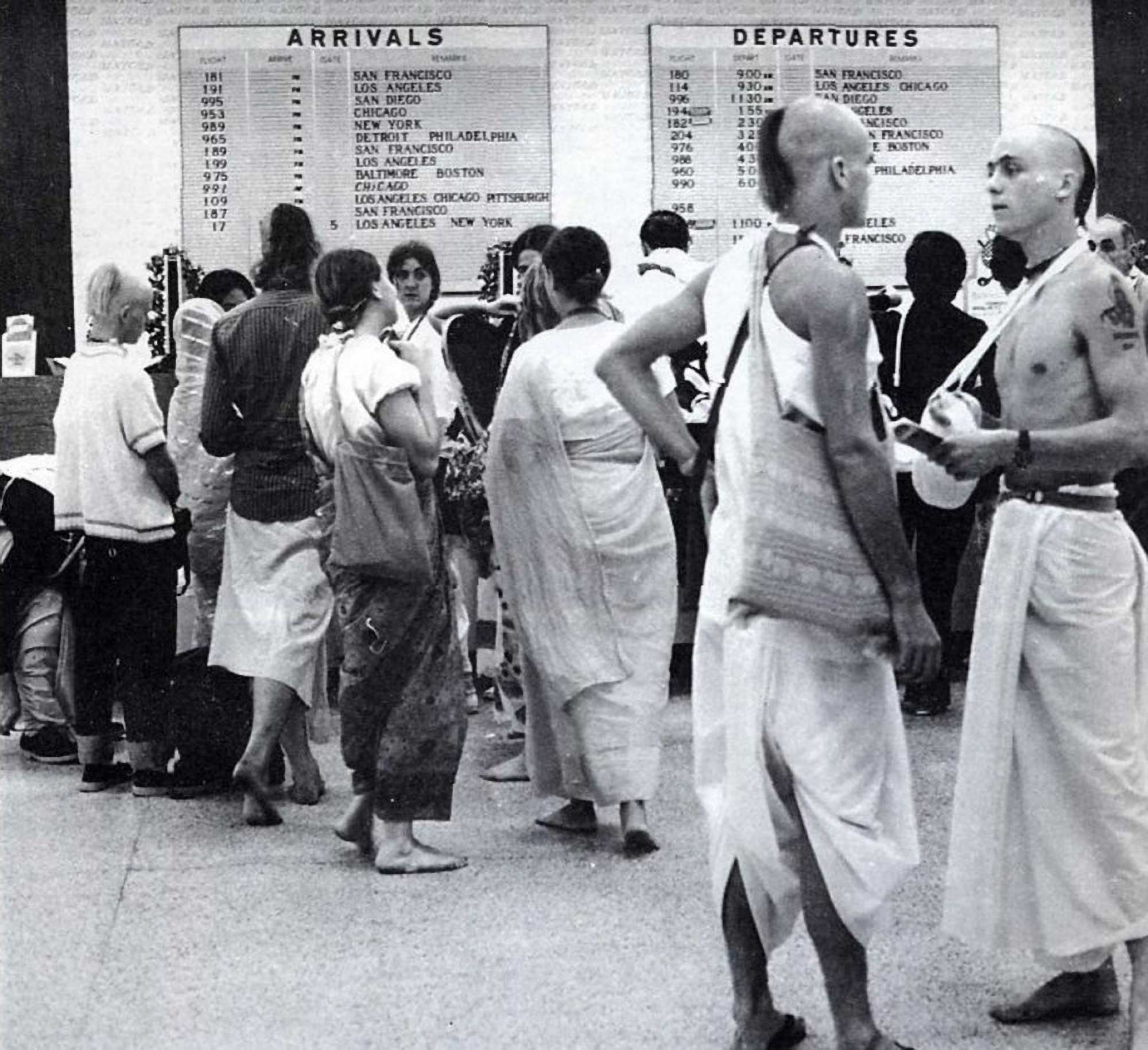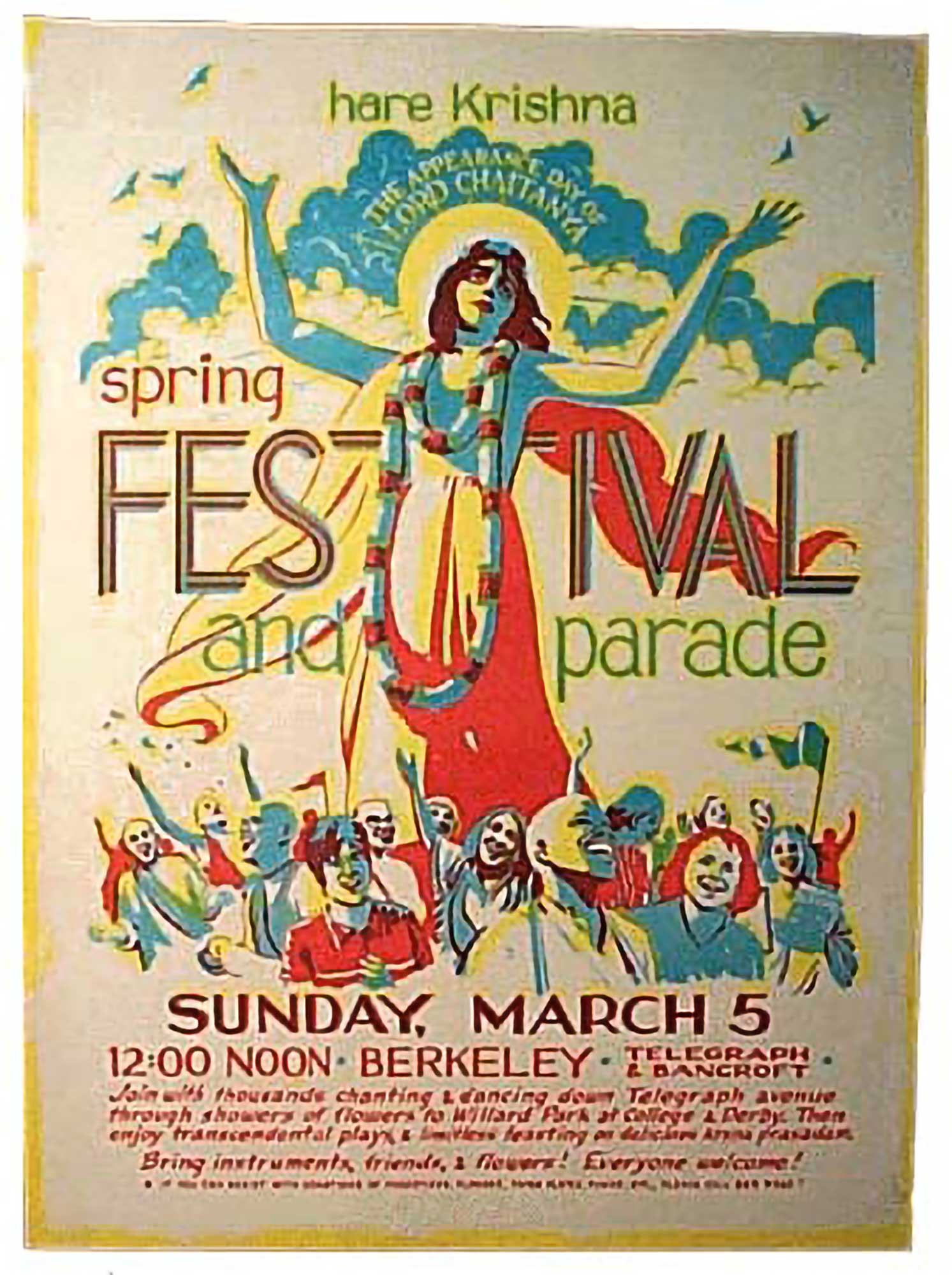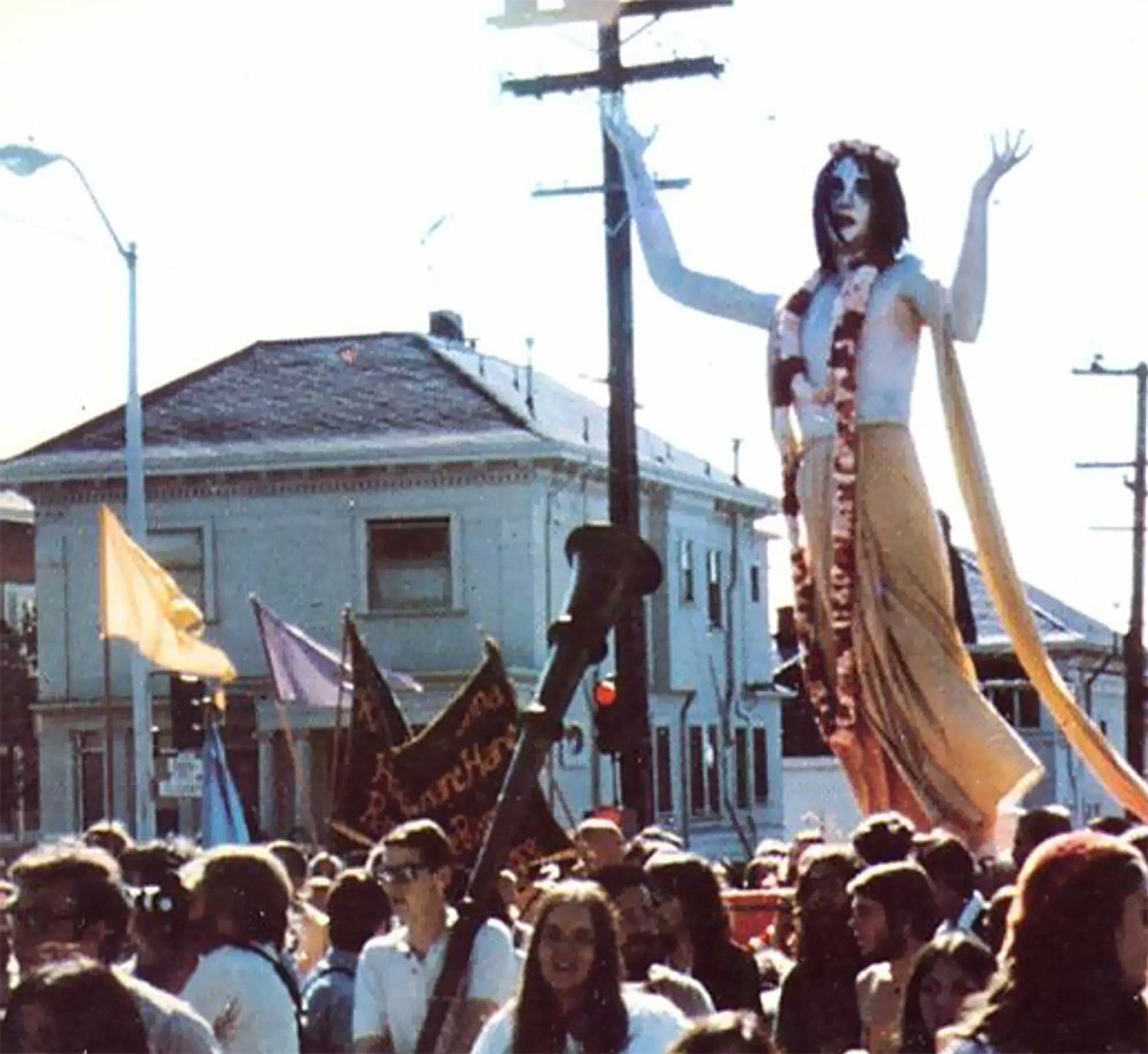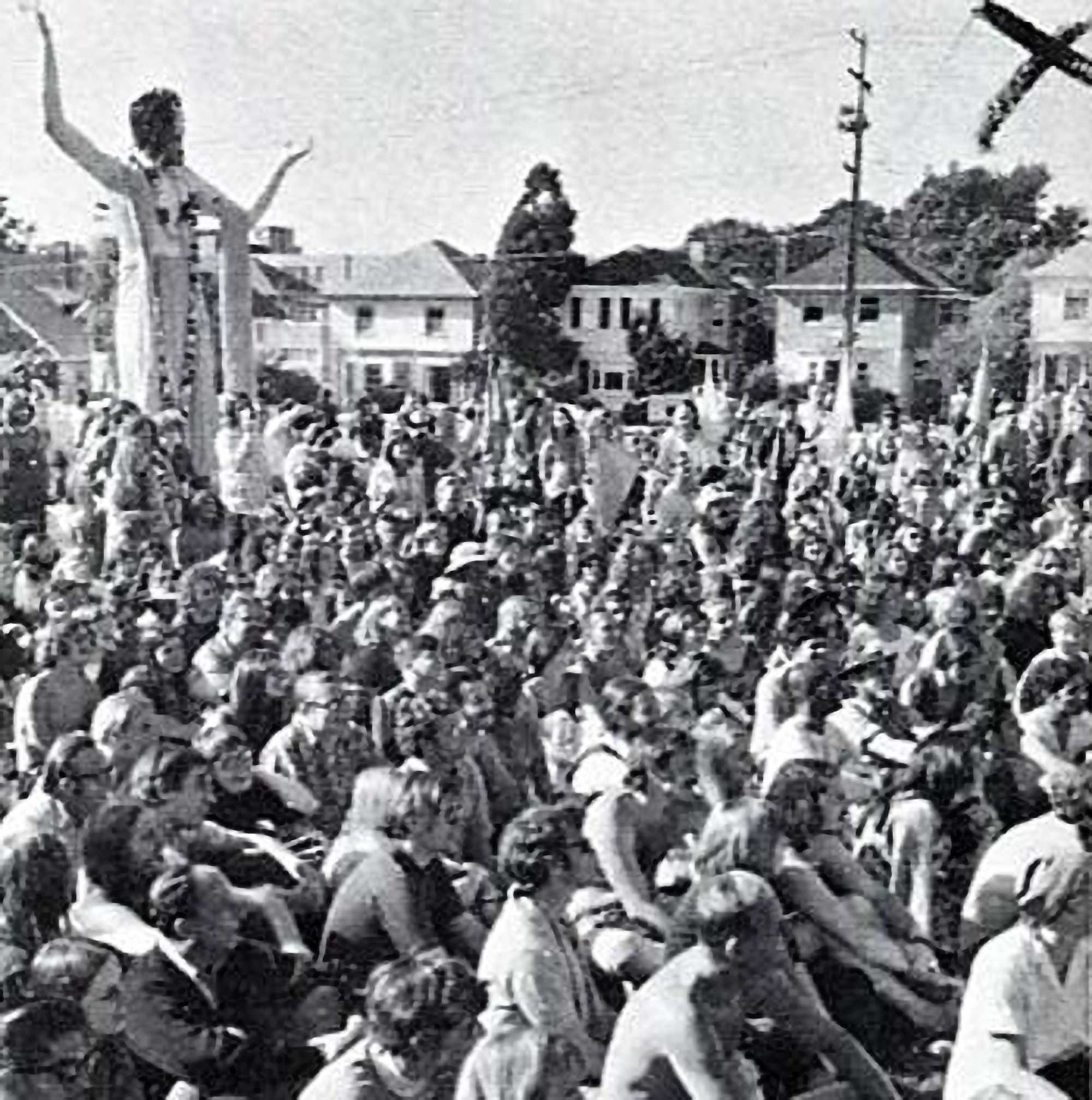Ācārya Siṁha
The Life of Swami Bhakti Gaurava Narasiṅgha Mahārāja
Chapter 7 – The Nine Chickpea Problem
(1970-1971)
Before leaving Hawaii, Sai gave all the vehicles and property that he owned to Gaurasundara and Govinda Dāsī and divided his followers into five groups of around ten members. One group was to go to the temple in Honolulu, one to Los Angeles, one to San Francisco, one to London, and one group went to India. Each party was carrying a donation of $10,000. Sai went with the San Francisco contingent and was later initiated by Śrīla Prabhupāda with the name Siddha-svarūpānanda Dāsa.
Narasiṅgha Mahārāja had been put in charge of the group that was travelling to Los Angeles.
Devotees from Hawaii in the Airport, 1970
Swami Narasiṅgha: So we boarded planes and all joined ISKCON. It was a big fly out day and there were some pictures taken – some of them were published in Back To Godhead magazine. There were basically ten of us in each group and whoever was left over went directly to see Śrīla Prabhupāda in India. My group was going to the temple in L.A. At that time, the L.A temple was the centre of the Hare Kṛṣṇa movement – there was no Māyāpura or Vṛndāvana. In my group there was Puṣkara, Mahendra and a few other devotees who ended up staying long term in the L.A devotee community. I was trusted with the $10,000 donation which was to be given on arrival to the temple authorities announcing our surrender.
And so it was that early on a dark, cold and rainy November morning, Mahārāja and his party arrived in two taxis unannounced at the L.A. Temple. While the temple devotees performed tulasī-pūjā, the group from Hawaii stood patiently outside for twenty minutes in the rain. Finally, the front door was opened by a devotee named Dayānanda who was totally taken off guard seeing the motley group standing in front of him – soaked to the skin, wearing polyester dhotis (which Mahārāja likened to wearing plastic shower-curtains), shaved up, shirtless and shoeless. Mahārāja stepped forward, handing him a bundle containing the donation. “We surrender, and we offer this $10,000 to the temple!” he announced. After a short pause, Dayānanda said, “Come on in!”
For the next few days, the temple president, Karandhara Dāsa, engaged the new devotees in almost every available service there was, with the exception of cooking and Deity worship – these two services were strictly for second initiated devotees.
Swami Narasiṅgha: You could not touch the fire in the kitchen unless you were second initiated. Uninitiated devotees or devotees with hari-nāma initiation could do everything, but they couldn’t cook. There could be four uninitiated devotees standing there ready to make chapattis – some of them five days away from initiation – but there was nobody to cook those chapatis! They would stand there in the kitchen until they found someone who was second initiated to do it. If the milk was boiling over – well, unless you were second initiated, you couldn’t turn it off. So it just boiled over!
But on his third day in the L.A. Temple, Mahārāja saw something that disturbed him…
Swami Narasiṅgha: I saw these three devotees drinking water directly from a tap outside and I thought, “What’s going on? They’re not offering the water!” At KYC in Hawaii we would fill up our bottles every day – about twenty or thirty litres – and offer the water as part of the breakfast offering.
So I went to Karandhara and I said, “We’re supposed to offer everything to Kṛṣṇa, right?”
Karandhara said, “Yeah. Devotees should only take what’s offered to Kṛṣṇa.”
“Well, You know, I don’t want to be a rat, but I just saw some real māyā!”
Karandhara asked, “What did you see?”
So I told him,“I just saw three devotees drinking water out of the tap.”
Karandhara was waiting for the punchline, like “They were taking LSD with the water!” But that was it. So then he said,“Well, we offer water to Kṛṣṇa when He has lunch, but when devotees drink water in the day they just say, ‘Śrī Viṣṇu, Śrī Viṣṇu, Śrī Viṣṇu.”
That was the ‘Śrī Viṣṇu Era’ – we were all very innocent and naive.
Although life at KYC had been quite regimented, it was more so in the L.A. Temple. Devotees would wake up at 4:00am, shower and then proceed to randomly get their clothes from a communal ‘grab bag.’ Often times, the clothes that one took didn’t fit or were mismatching and it was common to see devotees wearing odd coloured socks. If anyone would suggest swapping clothes with another devotee, he was swiftly met with a scowl and the retort, “Why are you so attached, prabhu?”
Gopī-candana tilaka from India was a rarity in any ISKCON temple in those days, and so the devotees became a little innovative. Thus, a mixture of Fuller’s earth and Elmer’s glue substituted the traditional tilaka. Mahārāja remembers how, due to the glue content, devotees were able to peel off their tilaka at night before taking rest, and if it had been a particularly sunny day, there would be a perfect imprint left on their foreheads!
After maṅgala-ārati and the morning class, devotees would go about their services. After a few weeks, Mahārāja was sent out on saṅkīrtana with two devotees – Makhanlāla Dāsa and Jaya Gopāla Dāsa.
Narasiṅgha Mahārāja: Makhanlāla and Jaya Gopāla – they were my first saṅkīrtana leaders. They were classic. They were the flip-side of the same coin. Both had very extreme personalities that stood out. Jaya Gopāla was quite a character and quite a saṅkīrtana leader. He would wear these thick leather gloves and he would beat the drum for at least seven to eight hours a day! That’s what it meant to be a ‘big devotee.’ There was no book distribution going on at that time. We would distribute Back To Godhead magazines and do hari-nāma for about eight hours or more every day. Unfortunately Jaya Gopāla ended up dying in a car accident on the L.A. freeway. Then Karandhara’s brother, Keśava took me on saṅkīrtana after that.
Mahārāja had only been in the temple for a month when one day, he was called into Karandhara’s office.
Narasiṅgha Mahārāja: Karandhara called me into the office and asked me if I was interested in getting married because someone was interested in me. I didn’t know how to react and before I could say anything, he points out of the window and said, “Well, she’s just out here” so I had a look. This lady was a fired-up sincere saṅkīrtana mātājī – no idea what her name was. But she was a big girl – as tall as me! She was putting these huge boxes of BTGs into the van, like picking two of them up at a time. I told him I wasn’t interested. I’d already seen so much misery in family life and to me, the idea of taking part in any of that was just absurd.
Just after new year in 1971, Mahārāja was called into Karandhara’s office once again. Mahārāja thought that Karandhara was going to push another potential wife upon him, but to his relief, the topic was altogether different. One devotee in Salt Lake City in Utah named Yaśodānandana had got into an argument with some of the devotees there and had returned to the L.A. temple. Karandhara wanted to send Mahārāja to Salt Lake City as a replacement.
When Mahārāja arrived at the Salt Lake City temple, he was met by Patraka Dāsa, the temple president, and a small cadre of brahmacāris – Janakarāja, Nārada Muni and Śrīnivāsa.
Patraka Dāsa: In September of 1970, just after having taken hari-nāma initiation from Śrīla Prabhupāda, I went to Salt Lake City in the company of three other brahmacārīs where we opened a temple. It was an austere undertaking at first, given that we only had one old Volkswagen that always needed repairs, one mṛdaṅga, three sets of karatālas, several boxes of Back To Godhead magazines, and no money. Yet, Prabhupāda encouraged us with letters and kind words, and coming from the mouth of His Divine Grace, we had all the strength and energy to continue on with our mission. Still, we realized that we needed help, and resulting from my plea for some assistance, Karandhara sent a new brahmacārī (Narasiṅgha Mahārāja) to help us.
The temple itself was quite dilapidated and, in the words of Mahārāja, “almost unfit for human habitation.” It was the dead of winter and there was no hot water in the temple. Taking a bath there was sheer torture.
If that wasn’t difficult enough, Karandhara had forwarded an instruction to Patraka that he said he had heard from Śrīla Prabhupāda concerning what the ideal daily prasādam consumption should be for a devotee. Prabhupāda had apparently said that in the morning devotees should take one scoop of oatmeal, half an orange, nine chickpeas and one cup of milk. In the afternoon, devotees could eat one scoop of subji, one scoop of rice, one cup of dahl and two chapatis. In the evening, nothing except another small cup of milk (the ‘cups’ in the temple were small, made of wax paper and held about 5oz).
Narasiṅgha Mahārāja: For someone like Karandhara, who was naturally austere, this diet was probably bordering on over-eating! The rest of us however, were a bunch of young men who were constantly hungry. We were jumping up and down on the street doing saṅkīrtana for eight hours a day.
The Salt Lake City temple was like living in a cave with a hard-ass drill-sergeant as our guru – that was Patraka! Rules didn’t bend – they just snapped back into place. But Patraka wasn’t just hard on us, he was also hard on himself. He would personally count out nine chickpeas for each devotee at breakfast and make sure that everyone got exactly what Prabhupāda had told Karandhara.
So in order to eat we would intentionally burn something in the kitchen. Generally it happened on Wednesday or Thursday nights because by then, we were practically starving to death. Whatever was burned was obviously unoffereable, but if you were starving, you’d still eat it! It could be anything – a tray of laddus, a curd subji, like that. It was an undiscussed plan – we all knew, but we never said a word to each other. In the evening after the program, Patraka would be in his office doing the accounts and we would all be in the brahmacārī āśrama chanting japa or reading and we’d keep looking at the clock. Then eventually we’d hear the cook Janakarāja open the kitchen door, take three steps into the prasādam hall and BAM! The pot would hit the counter and he would yell, “Blooped prep!” and three brahmacārīs would bolt out. Janakarāja had already taken his share and hidden it in the kitchen above the freezer unit, so the rest was for us. Patraka would hear that from his office, jump up and start shouting, “No, no, no! You can’t do that!”
Now the brahmacārī āśrama was just four steps to the counter. Patraka’s office was behind a curtain adjacent to the temple room. It was only a few steps away to the prasādam hall, but he had to go through the temple room where there was a picture of Prabhupāda and the Pañca-Tattva. So when he entered, he had to bow down, chant Prabhupāda’s full praṇāma-mantra, “Namaḥ oṁ viṣṇupādāya…” then he would run across the temple room, but before leaving the temple to enter the prasādam hall, he had to again bow down and chant,“Namaḥ oṁ viṣṇupādāya…” It was classic fanaticism! That gave us enough time to wolf down the burned prep. You think Vṛndāvana monkeys could stuff food in their mouths? They were nothing compared to us! Patraka would run in and read us the Riot Act, but it was too late.
Suffice to say that devotees were extremely conscious of prasādam. They were thinking about their next meal before they had even finished washing their hands and mouths after their last one. Mahārāja could remember that once, after a Sunday feast, he walked out of the temple to chant japa and found a full untouched plate of prasādam that a guest had thrown into a pile of snow a few hours previously. All the preps had frozen to the plate. Mahārāja picked it up, dusted the snow off it and ate it.
Eventually, a devotee in the L.A. temple came up with the perfect scheme to make sure that the devotees could follow Prabhupāda’s instructions to the letter, but at the same time, not starve to death. He simply got bigger spoons, bigger cups and they made bigger chapatis.
(As a side note, later, Śrīla Prabhupāda’s servant, Nanda Kumāra Dāsa personally asked him, “There’s a controversy about how many chickpeas we can eat. Some say seven, some say eleven, some say twenty-one.” Prabhupāda replied, “”Everyone is quoting this and that and this and that. Believe what you hear from me directly and what you read in my books. And as far as chickpeas are concerned, eat as many as you can digest.”)
The primary activity of the devotees at Salt Lake City was hari-nāma saṅkīrtana and distributing Back To Godhead magazines on the streets.
Narasiṅgha Mahārāja: Devotees did saṅkīrtana in the winter, the summer, in the snow, the sun, the rain, every single day. It didn’t matter – saṅkīrtana never stopped. Sometimes nobody else was out on the streets because it was raining, but we would still be out there! If we didn’t go out on saṅkīrtana, we had nothing else to do! It was māyā if you didn’t! Those devotees who did stay back for some reason were so green that they would either sleep all day or immediately fall into māyā – they’d get on the phone and call an old girlfriend or something like that! We were so new that when you woke up in the morning, you’d check if the guy that had been sleeping next to you was still there or not. Was he there, or did he get up in the middle of the night and bloop? That actually did happen sometimes. It was like living during the Black Death in the Middle Ages – you had no idea who was going to survive.
There was a major battle going on with all these young devotees for sense-control – every single person. If it wasn’t sex desire, it was anger issues, or hunger – all these things. It was visibly so. There were regular fights in the brahmacārī āśramas. Tensions were high, all coming out of frustration. We were very neophyte – sincere, but neophyte.
San Fransisco Gaura Purnima Festival, 1971
At the beginning of March, Mahārāja and all the devotees at Salt Lake City travelled to Berkeley for the annual Gaura Pūrṇimā festival. The Berkeley temple was a large, old house close to the University of California and was run by Jayānanda Dāsa, a very famous and dedicated disciple of Śrīla Prabhupāda. Jayānanda had organised the Gaura Pūrṇimā festival and planned for a procession to go right down Bancroft Way, the main street next to the university campus. The Temple President of Portland, Locana Dāsa, had made a set of Gaura-Nitāi that were about 20 feet high which were taken down the street to the accompaniment of hari-nāma saṅkīrtana. As hundreds of devotees turned up from all the centres in the United States and Canada, Jayānanda had some of them go door-to-door, handing out flyers and inviting people to the festival.
San Fransisco Gaura Purnima 1971
However, on the day of Gaura Pūrṇimā itself, the weather started to look as if it would rain. The procession went ahead, but just as it was almost over, the clouds burst and it poured. Jayānanda was determined not to let the weather effect the program, so he invited the entire crowd of spectators back to the temple for prasādam. So many people came that the walls of the temple seemed as if they were going to burst. Devotees distributed prasādam non-stop and kīrtana went on throughout the afternoon and evening. Mahārāja was deputed to help Jayānanda preparing prasādam.
Swami Narasiṅgha: It was cold and it rained and rained and rained. Jayānanda grabbed me and I became the man on the garden hose that filled the fifty gallon containers we had for lemonade. He was dumping in synthetic lemon concentrate and busting open ten pound bags of white table sugar. Now being a new devotee, I saw that he hadn’t offered it (not even ‘Śrī Viṣṇu-ed’ it), so I said, “Oh, but it’s not offered” and Jayānanda replied, “No, it’s offered.” I don’t remember his exact words, but he quickly explained, “When we’re distributing, we are giving it to the people so it is prasādam.” In other words, we are doing all this for Kṛṣṇa, not for ourselves, so it is prasādam. Anyhow those containers were put on dollys, and were wheeled over to the where we were distributing prasādam. I remember when the containers had been emptied and all that was left was the sugary sludge at the bottom, some of us thought, “Mahā-prasāda!” and we ate it! Desperate times…
San Fransisco Gaura Purnima 1971
During the festival, Mahārāja noticed Karandhara who had arrived with the devotees from the L.A. temple. Mahārāja had already decided that he couldn’t work under Patraka any longer – the situation at Salt Lake City was simply intolerable for him. They were constantly on the verge of starvation, the temple was a dive, and Patraka was too rigid. He approached Karandhara and told him that either he should be posted to another temple, or he was going to bloop! Karandhara immediately called over a devotee named Śukadeva, who was the temple president of Tucson, Arizona. They conferred together for a while, then Karandhara turned to Mahārāja and told him that he was now a member of Iskcon Tucson.
Swami Narasiṅgha: I wasn’t actually going to bloop – I just threatened to. So I played my card and they went for it! If Karandhara had said, “OK, go ahead and bloop!” I wouldn’t have known what to do! After the festival I left with Śukadeva. I didn’t tell Patraka – I left that to Karandhara.
Mahārāja got on very well with Śukadeva and happily did saṅkīrtana with the devotees in Tucson. Mahārāja remembers that one of his daily services there was to go outside at 4:00am and wake up an aspiring devotee who was sleeping in his milk-truck opposite the temple. In that way he would be able to attend maṅgala-ārati. He later took initiation on the same day as Mahārāja and became known as Kavicandra Dāsa (later Kavicandra Swami).
In the month of June, Śukadeva took all the Tucson devotees to San Francisco for the Ratha Yātrā festival. It was a very exciting time for the devotees, and especially for Mahārāja since Śrīla Prabhupāda himself would be present there. Previously, when he had visited the Fredrick Street temple in San Francisco, he had been in the presence of Śrīla Prabhupāda, but the temple had been so packed with devotees and guests dancing wildly, that he could not see His Divine Grace.
This time however, was different. This time he would actually get to see Śrīla Prabhupāda!












